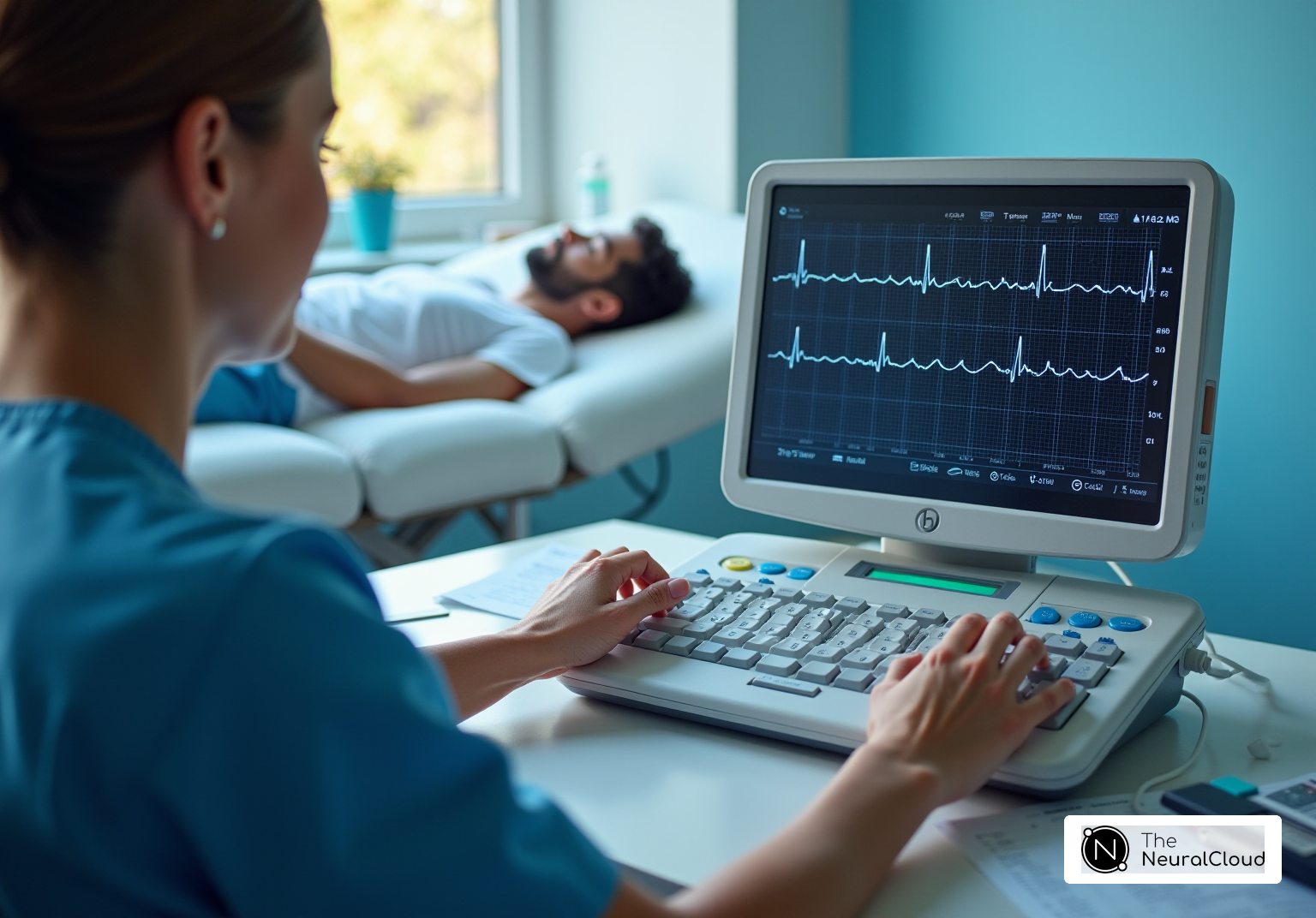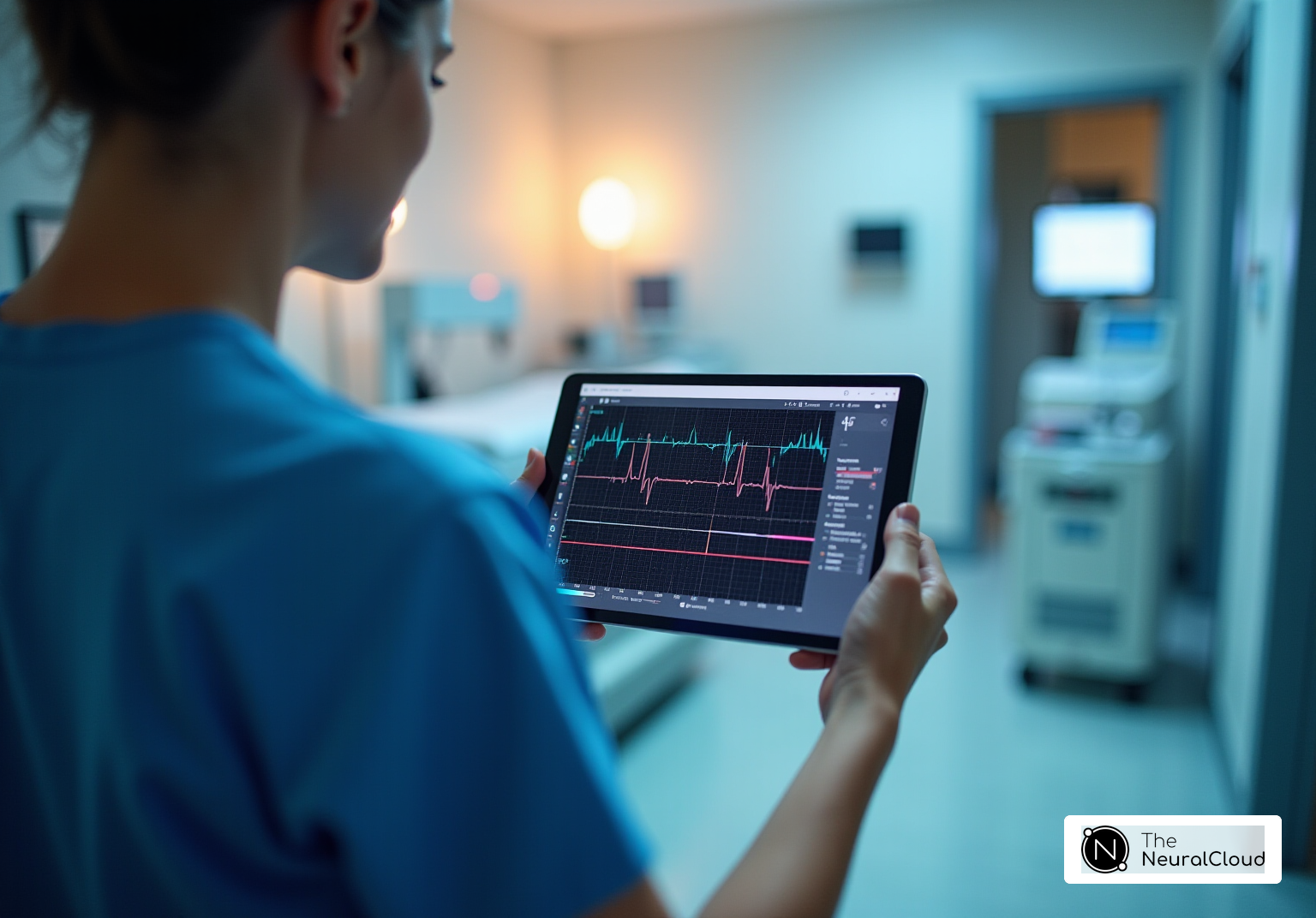Electrocardiogram (ECG/EKG) machines are vital tools in modern medicine, enabling healthcare providers to monitor and analyze the electrical activity of the heart. This blog will delve into the intricacies of ECG machines and what they measure. Then we dive into the advancements in wireless ECG monitoring technology and the role of ECG software and libraries. Finally, we discuss our groundbreaking ECG labeling Neural Network and how it is transforming cardiac care.
What is an ECG Machine and What Does it Measure?
An EKG/ECG machine records the electrical activity of the heart over the period the person is wearing it. So, what information does an ecg give about a person?
The machine measures the time intervals and the amplitude of the electrical impulses as they travel through the heart. This provides a detailed graphical representation of the heart's function. This electrical activity is crucial for diagnosing various cardiac conditions, including arrhythmias, myocardial infarctions, and other heart diseases.
How Does an EKG Machine Work?
An EKG machine works by detecting and amplifying the electrical impulses generated by the heart. Placing electrodes on the patient's body as specific locations can pick up these impulses. Here’s a step-by-step breakdown of the process:
- Electrode Placement: Electrodes are placed on the patient’s chest, arms, and legs. These electrodes are conductive pads that detect the electrical signals produced by the heart.
- Signal Detection: The electrodes detect the tiny electrical changes on the skin. The heart muscle's depolarization during each heartbeat causes this.
- Amplification: The detected signals are extremely weak. So, the machine amplifies them to a level where they can be accurately recorded.
- Recording: The amplified signals are recorded and displayed as waveforms on a monitor or printed on paper. These waveforms are what we see as the P wave, QRS complex, and T wave.
Parts of Different ECG Machines
Electrocardiogram machines can vary in complexity, but they generally consist of the following key parts:
- Electrodes: Conductive pads placed on the patient’s skin.
- Lead Wires: Connect the electrodes to the ECG machine.
- Amplifier: Boosts the weak electrical signals detected by the electrodes.
- Analog-to-Digital Converter: Converts the amplified analog signals into digital form for processing and display.
- Display/Printer: Shows the ECG waveforms on a screen or prints them on paper.
- Software: Analyzes the digital signals to provide insights and diagnostic information.
Wireless ECG Leads and Machines
Advancements in technology have led to the development of wireless ECG sensors and machines. These devices offer several advantages over traditional wired systems, including greater mobility, reduced risk of infection, and increased patient comfort.
- Wireless ECG Leads: These leads transmit the electrical signals from the electrodes to the ECG machine. They use Bluetooth or other wireless communication technologies. This eliminates the need for cumbersome wires and allows patients to move freely during monitoring.
- Portable ECG Machines: The ECG device itself is compact and lightweight. This makes it easy to use in a variety of settings, from hospitals to remote locations. They often integrate with smartphones or tablets, providing real-time data to healthcare providers.
Software and Libraries
ECG analysis software plays a crucial role in the post-processing and interpretation of the recorded data. Numerous software solutions and ECG libraries are available that offer a range of functionalities, including:
- Signal Processing: Filters noise and enhances the quality of the signals.
- Automated Analysis: Identifies and labels different parts of the waveform. This includes the P wave, QRS complex, and T wave, as well as their onsets and offsets.
- Diagnostic Tools: Provides algorithms for detecting arrhythmias, ischemia, and other cardiac conditions.
- Data Storage and Management: Stores data for future reference and integrates with electronic health records (EHRs).
Revolutionary MaxYield™ Technology: Our Solution
Currently, the market offers various ECG reading technologies, ranging from traditional wired machines to advanced wireless systems. However, our ECG labeling Neural Network, MaxYield, stands out as a revolutionary advancement in this field.
Our MaxYield™ software is capable of rapidly labeling ECG files of any length. This provides an accurate and efficient overview of the heart's health. Here’s why our technology is groundbreaking:
- Rapid and Accurate Labeling: The Neural Network can analyze and label ECG data in minutes. This is significantly faster than traditional methods. For example, it can beat-by-beat label a 48-hour-long ECG file accurately in less than 5 minutes.
- Pinpointing Irregularities: It can highlight irregularities and anomalies within the ECG file, making it easier for healthcare providers to identify potential issues.
- Efficient Post-Processing: By reducing the time spent on interpreting the data, our Neural Network allows for quicker transition to post-processing, diagnosis, and treatment.
- Cost-Effective: It saves time, money, and resources, streamlining the workflow in clinical settings.
How Our Neural Network Enhances ECG Analysis
Our Neural Network leverages advanced machine learning algorithms to deliver unparalleled accuracy and efficiency in electrocardiac analysis. Our system is device agnostic, ensuring seamless integration with any existing ECG technology. Whether it be traditional machines or the latest wearable devices, it provides unparalleled flexibility and adaptability in diverse healthcare environments. This enables healthcare providers to leverage its powerful capabilities without the constraints of specific hardware.
Here’s how it makes an immediate impact:
- Compatibility with Older and Newer Tech: MaxYield is compatible with both old and new technology. It can work with traditional ECG machines as well as wireless devices. This compatibility allows for improved analysis and seamless integration.
- Real-Time Analysis: The Neural Network processes data in real-time. This offers immediate insights and reduces the wait time for diagnosis.
- Improved Patient Outcomes: By enabling faster and more accurate diagnosis, our technology facilitates timely medical intervention, leading to better patient outcomes.
- Enhanced Monitoring: For wearables and wireless leads, our Neural Network can support continuous monitoring of heart activity. This will ensure prompt detection of any irregularities.
Conclusion
The ECG machine is a cornerstone of modern cardiac care, providing vital insights into the heart's electrical activity. From traditional wired systems to advanced wireless technology, the evolution of these devices has significantly improved patient care. However, the integration of our MaxYield engine marks a new era in ECG analysis.
Our Neural Network can quickly and accurately label ECG data, identify irregularities, and simplify post-processing. It will revolutionize cardiac diagnostics, improving efficiency and patient outcomes.







